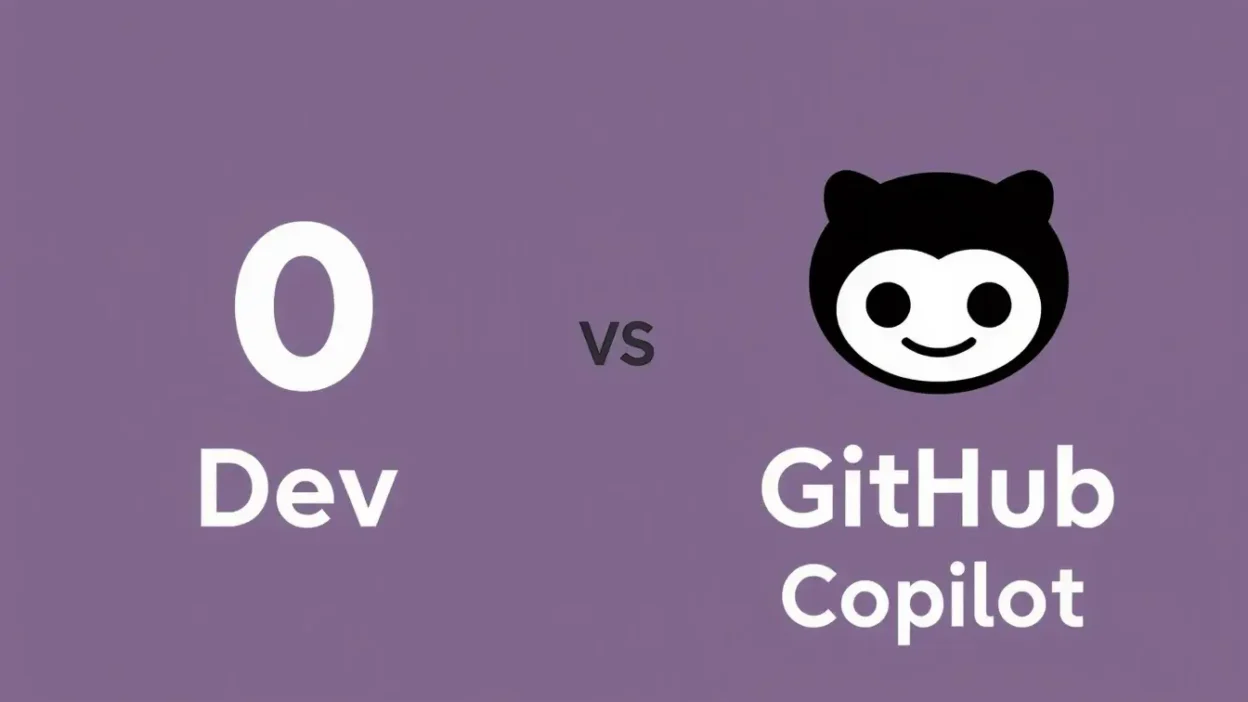Table of Contents
v0 dev vs GitHub Copilot:(Which AI Tool Wins?)
In the rapidly evolving landscape of AI-powered development tools, developers face a growing challenge: choosing the right assistants for their workflow. Two prominent players in this space—v0 dev and GitHub Copilot—have captured significant attention, but confusion persists about their distinct purposes and capabilities.
If you’re weighing v0 vs Copilot or researching either tool individually through a v0.dev review or GitHub Copilot review, you’ve come to the right place. This comprehensive comparison breaks down exactly how these tools differ and when to use each one.
Quick Summary: v0 dev is primarily a UI generation tool that transforms text descriptions and images into React components with Tailwind CSS, while GitHub Copilot functions as an AI pair programmer that helps write, explain, and refine code across numerous languages and frameworks. While they appear similar as AI coding assistants, they solve fundamentally different problems in the development workflow.
What is v0 dev? A Closer Look
Core Function
v0 dev, developed by Vercel, is a specialized AI tool designed to revolutionize the frontend development process. Its primary purpose is generating UI components and layouts from text prompts or images, delivering production-ready React components styled with Tailwind CSS.
How v0 dev Works
The v0 workflow centers around an iterative design process:
- Start with a text prompt describing your desired UI or upload an image
- v0 generates the corresponding React + Tailwind component
- Fork, modify, and refine through additional prompts
- Export the final code for your project
v0 dev Key Features
- Prompt-to-UI Generation: Transform written descriptions into functional UI components
- Image-to-UI Conversion: Upload screenshots or mockups to generate matching code
- Component-Level Focus: Generate specific UI elements like cards, forms, or navigation bars
- High-Quality Code Output: Clean, well-structured React code with Tailwind classes
- Iterative Refinement: Ability to fork and modify generated components
- Visual Preview: Real-time rendering of your generated components
- Code Export: Download or copy the final code for your project
Target User
v0.dev primarily serves frontend developers and UI/UX designers who are comfortable with code. It’s particularly valuable for those working with React and Tailwind CSS ecosystems.
What is GitHub Copilot? A Closer Look
Core Function
GitHub Copilot functions as an AI pair programmer, offering real-time code suggestions, completions, and assistance directly within your development environment. Unlike v0’s specialized UI focus, Copilot provides broad coding assistance across numerous languages and tasks.
How GitHub Copilot Works
Copilot integrates seamlessly into popular IDEs, analyzing your code context to provide relevant suggestions:
- Write comments describing what you need or start typing code
- Copilot generates suggestions based on your context and intent
- Accept, modify, or reject suggestions
- Use Copilot Chat for more complex interactions and explanations
GitHub Copilot Key Features
- Contextual Code Completion: Suggests code based on your current file and comments
- Function Generation: Creates complete functions based on descriptive comments
- Boilerplate Reduction: Automatically generates repetitive code patterns
- Copilot Chat: Conversational interface for questions, explanations, and code generation
- Multi-Language Support: Works across dozens of programming languages
- Bug Detection and Fixing: Helps identify and resolve code issues
- Test Generation: Creates test cases based on implementation code
- IDE Integration: Works natively in VS Code, JetBrains IDEs, and others
- Documentation Assistance: Helps create comments and documentation
Target User
GitHub Copilot serves all types of developers—frontend, backend, data science, DevOps—regardless of language or framework preferences.
Head-to-Head Comparison: v0.dev vs GitHub Copilot
| Criteria | v0 dev | GitHub Copilot |
|---|---|---|
| Primary Goal | UI/Component Generation | Code Assistance Across All Tasks |
| Input Method | Text Prompts, Image Uploads | Code Context, Comments, Chat |
| Output | React Components with Tailwind CSS | Code Snippets in Various Languages |
| Integration | Web Application | IDE Extensions |
| Core Technology | Visual Generation Models | Large Language Models for Code |
| Workflow | Generate & Refine UI Components | Inline Code Assistance & Chat |
| Language Focus | React/Tailwind (primarily) | 30+ Programming Languages |
| Learning Curve | Moderate (requires prompt engineering) | Low (works with existing coding patterns) |
| Customization | Iterative refinement of components | Fine-tuning through prompts and editing |
| Pricing Model | Free tier with limits, Pro tier for $20/month | $10/month or $100/year (individual) |
| Ideal Use Case | Rapidly creating UI components from concepts | Accelerating general coding tasks |
Deep Dive: Strengths and Weaknesses
v0 dev Pros
- Dramatically speeds up UI prototyping and component creation
- Transforms visual concepts directly into production-ready code
- Eliminates repetitive frontend implementation work
- Produces consistent, well-structured React components
- Excellent for quickly exploring UI variations
- Particularly strong at generating responsive designs with Tailwind
v0 dev Cons
- Currently limited primarily to React and Tailwind CSS
- Sometimes requires multiple iterations to achieve exact specifications
- Less control over fine implementation details
- Still maturing as a platform with occasional inconsistencies
- Dependency on the Vercel ecosystem
- Not suitable for complex application logic or backend development
GitHub Copilot Pros
- Accelerates development across the entire codebase
- Works with virtually any programming language or framework
- Strong IDE integration creates a seamless workflow
- Reduces time spent on documentation and Stack Overflow searches
- Copilot Chat provides versatile problem-solving capabilities
- Helps with learning new languages and frameworks
- Extremely useful for boilerplate code, tests, and documentation
GitHub Copilot Cons
- Can sometimes generate incorrect or inefficient code
- Requires careful review to ensure quality and security
- May raise licensing concerns with generated code
- Less helpful for complex architectural problems
- Can potentially become a crutch for newer developers
- Quality varies by language and framework familiarity
- Not specialized for UI generation like v0.dev
Use Cases: When to Choose Which Tool (Or Both?)
Use v0 dev When:
- You need to rapidly prototype UI interfaces
- You want to transform mockups or wireframes into React code
- You’re exploring different layout options visually
- You want to bootstrap frontend components quickly
- You’re working specifically with React and Tailwind CSS
- You’re creating standardized UI components for your design system
Use GitHub Copilot When:
- You need assistance writing any type of code (not just UI)
- You want inline suggestions while coding
- You’re working across multiple languages and frameworks
- You need help with algorithms, data structures, or business logic
- You want assistance debugging or explaining code
- You’re writing tests, documentation, or configuration files
- You need to work with APIs, databases, or backend systems
Using Them Together (Complementary Workflow):
The most powerful approach might be using both tools in tandem:
- Generate initial UI components with v0.dev
- Import the generated code into your IDE
- Use GitHub Copilot to refine the code, add logic, implement state management
- Let Copilot help connect your UI to APIs and backend services
- Use Copilot to generate tests for your components
This complementary workflow leverages v0’s UI generation strengths with Copilot’s broader coding assistance, creating a powerful development pipeline.
FAQ
Q: What is the main difference between v0 dev and GitHub Copilot?
A: The primary difference is their focus: v0.dev specializes in generating UI components from text and image prompts, while GitHub Copilot is a general-purpose coding assistant that helps with all aspects of software development across multiple languages.
Q: Can GitHub Copilot generate UI like v0 dev?
A: While Copilot can generate HTML, CSS, and JavaScript code, it doesn’t offer the same visual, iterative UI generation experience as v0 dev. Copilot lacks v0’s specialized UI focus and component refinement capabilities, though it can certainly help with implementing UI code.
Q: Is v0 free? Is Copilot free?
A: v0.dev offers a free tier with limitations on generations and a Pro tier at $20/month for additional features and higher limits. GitHub Copilot costs $10/month or $100/year for individual developers, with enterprise pricing available for teams. Neither tool is completely free for unlimited use.
Q: Which tool is better for beginners?
A: For pure beginners, GitHub Copilot might be more accessible as it works within familiar IDEs and helps with learning through explanations and suggestions. v0 dev requires some understanding of React and Tailwind CSS to effectively utilize the generated code. However, both tools can significantly flatten the learning curve in their respective domains.
Q: Do I need both v0 and Copilot?
A: Not necessarily, but they complement each other well. If you primarily work on UI development with React and Tailwind, v0 dev alone might be sufficient. If you work across the full stack, GitHub Copilot provides broader assistance. For comprehensive development acceleration, the combination offers significant advantages.
The Future of AI Development Tools
As AI continues to transform software development, we can expect both tools to evolve significantly:
v0 dev will likely expand beyond its current React/Tailwind focus to support additional frameworks like Vue, Angular, or Svelte. We may also see deeper integration with design tools and more sophisticated component generation capabilities.
GitHub Copilot is rapidly improving its contextual understanding and expanding its capabilities beyond code completion. Future versions will likely feature improved accuracy, more sophisticated Copilot Chat interactions, and potentially stronger visual generation capabilities.
The most interesting trend to watch is whether these tools will converge or further specialize. Will Copilot develop stronger UI generation features? Will v0 expand beyond UI into broader application logic? This evolving landscape makes it an exciting time for developers embracing AI assistance.
Conclusion & Recommendation
When comparing v0 dev vs GitHub Copilot, it’s clear that these tools serve different primary purposes despite both being AI-powered developer assistants.
v0 dev excels at transforming concepts into UI components, dramatically accelerating frontend development with React and Tailwind CSS. It’s the go-to choice when you need to quickly generate user interfaces from ideas or mockups.
GitHub Copilot shines as a versatile coding companion that helps with everything from implementation and debugging to documentation and testing across numerous languages and frameworks.
Rather than choosing one over the other, consider how they might fit into your specific development workflow. Frontend specialists might lean heavily on v0.dev, full-stack developers might prefer Copilot’s versatility, and teams with dedicated UI/UX focus might benefit most from using both tools in tandem.
As AI development tools continue to evolve, staying adaptable and experimenting with different assistants will likely yield the greatest productivity gains. The question isn’t whether to use AI in your development process—it’s how to most effectively integrate these powerful tools into your workflow.
What are your experiences with v0 or Copilot? Which tool do you prefer and why? Share your thoughts and use cases in the comments below!





